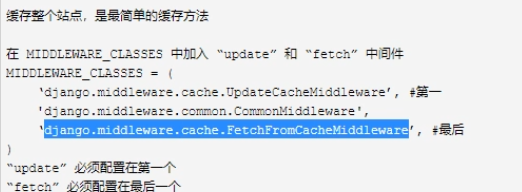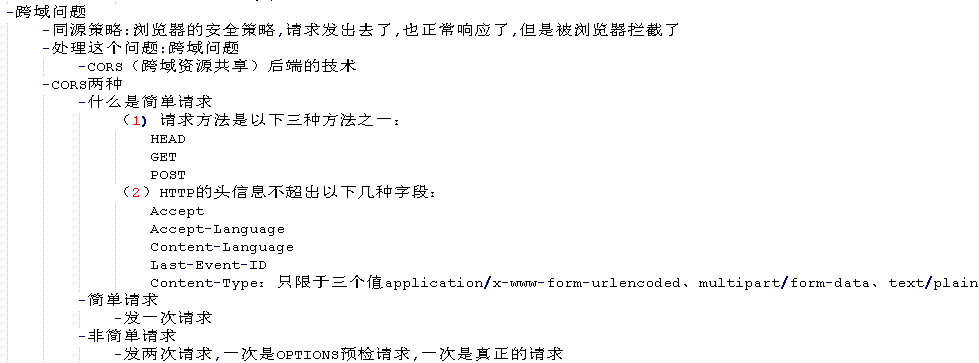drf版本控制


基于url的get传参方式
REST_FRAMEWORK={
# "DEFAULT_AUTHENTICATION_CLASSES":["app01.auth.AuthLogin",],
# "DEFAULT_PERMISSION_CLASSES":['app01.auth.MyPer'],
# "DEFAULT_THROTTLE_CLASSES":["app01.auth.VisitThrottle"],
'DEFAULT_PARSER_CLASSES':['rest_framework.parsers.JSONParser'],
'DEFAULT_THROTTLE_RATES': {
'luffy': '3/mmmmmm'
},
'DEFAULT_VERSION': 'v1', # 默认版本(从request对象里取不到,显示的默认值)
'ALLOWED_VERSIONS': ['v1', 'v2'], # 允许的版本
'VERSION_PARAM': 'version' # URL中获取值的key
}
基于url的正则方式
url(r'^(?P<version>[v1|v2]+)/publishs/', views.PublishView.as_view()),

django缓存


CACHES = {
'default': {
# 1. MemCache 基于MemCache的缓存
# 'BACKEND': 'django.core.cache.backends.memcached.MemcachedCache',
# 'LOCATION': '127.0.0.1:11211',
# 2. DB Cache 基于数据库的缓存
# 'BACKEND': 'django.core.cache.backends.db.DatabaseCache',
# 'LOCATION': 'my_cache_table',
# 3. Filesystem Cache 基于文件的缓存
# 'BACKEND': 'django.core.cache.backends.filebased.FileBasedCache',
# 'LOCATION': '/var/tmp/django_cache',
# 4. Local Mem Cache 基于内存的缓存
'BACKEND': 'django.core.cache.backends.locmem.LocMemCache',
'LOCATION': 'backend-cache'
}
}
import os
import time
import django
from django.core.cache import cache
os.environ.setdefault('DJANGO_SETTINGS_MODULE', 'backend.settings')
django.setup()
def basic_use():
s = 'Hello World, Hello Django Cache.'
cache.set('key', s)
cache_result = cache.get('key')
print(cache_result)
s2 = 'Hello World, Hello Django Timeout Cache.'
cache.set('key2', s2, 5) #5是超时时间
cache_result = cache.get('key2')
print(cache_result)
time.sleep(5) #5秒后就查不到了
cache_result = cache.get('key2')
print(cache_result)
pass
if __name__ == '__main__':
basic_use()
#实例
# 星座运势
def constellation(request):
data = []
if already_authorized(request):
user = get_user(request)
constellations = json.loads(user.focus_constellations)
else:
constellations = all_constellations
for c in constellations:
result = cache.get(c)
if not result:
result = thirdparty.juhe.constellation(c)
timeout = timeutil.get_day_left_in_second()
cache.set(c, result, timeout)
logger.info("set cache. key=[%s], value=[%s], timeout=[%d]" %(c, result, timeout))
data.append(result)
response = CommonResponseMixin.wrap_json_response(data=data, code=ReturnCode.SUCCESS)
return JsonResponse(response, safe=False)
settings:
CACHES = {
'default': {
'BACKEND': 'django.core.cache.backends.filebased.FileBasedCache', # 指定缓存使用的引擎
'LOCATION': r'D:lqzvue', # 指定缓存的路径
'TIMEOUT': 300, # 缓存超时时间(默认为300秒,None表示永不过期)
'OPTIONS': {
'MAX_ENTRIES': 300, # 最大缓存记录的数量(默认300)
'CULL_FREQUENCY': 3, # 缓存到达最大个数之后,剔除缓存个数的比例,即:1/CULL_FREQUENCY(默认3)
}
}
}

views:
from django.shortcuts import render,HttpResponse
# Create your views here.
from django.views.decorators.cache import cache_page
import time
# 单页面缓存缓存5秒
# @cache_page(20)
def test(request):
print('我来了')
ctime=time.time()
return render(request,'test.html',locals())
templates:
<!DOCTYPE html>
<html>
<head>
<meta charset="UTF-8">
<script src="/static/jquery-3.3.1.js"></script>
<title>Title</title>
</head>
<body>
不缓存的
{{ ctime }}
<br>
缓存的的
{#{% load cache %}#}
{#第一个参数是超时时间,缓存时间,第二个参数是key值,别名#}
{#{% cache 10 'test' %}#}
{# {{ ctime }}#}
{#{% endcache %}#}
<button id="btn">点我发请求</button>
</body>
<script>
$("#btn").click(function () {
$.ajax({
url:'http://127.0.0.1:8000/v1/publishs/',
type:'get',
{# type:'delete',#}
{# type:'put',#}
{# contentType:'application/json',#}
{# data:JSON.stringify({'name':'lqz'}),#}
success:function (data) {
console.log(data)
}
})
})
</script>
</html>
跨域问题


from django.utils.deprecation import MiddlewareMixin
class CORSMiddle(MiddlewareMixin):
def process_response(self,request,response):
response['Access-Control-Allow-Origin'] = 'http://127.0.0.1:8001'
if request.method == 'OPTIONS':
response['Access-Control-Allow-Methods'] = 'PUT,DELETE'
response['Access-Control-Allow-Headers']='Content-Type'
return response